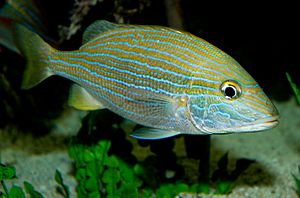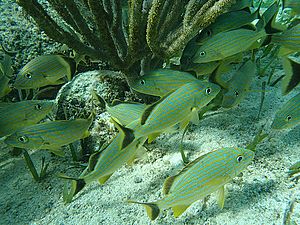Bluestriped grunt facts for kids
Quick facts for kids Bluestriped grunt |
|
|---|---|
 |
|
| Conservation status | |
| Scientific classification | |
| Genus: |
Haemulon
|
| Species: |
sciurus
|
| Synonyms | |
|
|
The bluestriped grunt (Haemulon sciurus) is a colorful fish that lives in the warm waters of the western Atlantic Ocean. It's also known by other names like the boar grunt or yellow grunt. This fish gets its name "grunt" because it can make a grunting sound! It belongs to a group of fish called grunts, which are part of the family Haemulidae.
Contents
What Does the Bluestriped Grunt Look Like?
The bluestriped grunt has a deep, almond-shaped body. Its head and body are bright yellow with thin, blue stripes running along them. There's also a cool arched blue stripe right under each eye.
Fins and Colors
The top fin on its back (called the dorsal fin) is yellow in the front and dark towards the back. Its tail fin (called the caudal fin) is dark, and the fin on its belly (called the anal fin) is yellowish. The fins on its sides (called the pelvic and pectoral fins) are whitish. If you look inside its mouth, you'll see it's a bright red color!
How They Change as They Grow
When bluestriped grunts are very young, smaller than about 22 millimeters (less than an inch), they have dark spots (called melanophores) near their tail. As they grow, these spots get bigger and form a dark stripe from behind their eye all the way to their tail. Once they reach about 50 millimeters (2 inches), they change to the bright yellow and blue colors of the adult fish. These fish can grow up to 46 centimeters (about 18 inches) long, but they are usually around 25 centimeters (10 inches).
Where Do Bluestriped Grunts Live?
You can find bluestriped grunts in the western part of the Atlantic Ocean. They live along the coast of the United States, from South Carolina down to the Bahamas. They are also found in the Gulf of Mexico, especially around the Florida Keys and along the northern coasts of the Yucatan Peninsula in Mexico. You can also spot them all over the Caribbean Sea.

Bluestriped Grunt Homes and Habits
Bluestriped grunts like to live in shallow waters, usually between 1 and 40 meters (3 to 130 feet) deep. They are often found in places like mangroves, coral reefs, and areas with lots of sea grass.
Daily Life of a Grunt
Adult bluestriped grunts often gather in small groups over coral and rocky areas, especially near drop-offs in the ocean floor. Younger grunts love to hide among beds of turtle grass (a type of sea grass) in very shallow water.
These fish are busy at night! They go out to hunt for food like smaller fish, crabs, shrimp, and clams in the sea-grass beds and mangroves. During the day, they rest in rocky areas to stay safe.
Making Grunting Noises
Bluestriped grunts are known for making a grunting noise. They do this by rubbing special teeth in their throat (called pharyngeal teeth) together. They also sometimes push each other backwards with their mouths open, which is a way they interact.
Who Eats the Grunt?
Larger fish, like sharks and groupers, often hunt bluestriped grunts. Like many animals, bluestriped grunts can also have tiny creatures called parasites living on or inside them.
How Were Bluestriped Grunts Discovered?
The bluestriped grunt was first officially described in 1803 by an English zoologist named George Shaw. He gave it the scientific name Sparus sciurus. The word sciurus means "squirrel," and at the time, people sometimes called this fish a "squirrelfish" because of the grunting sounds it makes.
Bluestriped Grunts and People
People catch bluestriped grunts using fishing lines, traps, and large nets (called seines). The fish is usually sold fresh to eat. While it's not very common to see them in home aquariums, you might spot them in large public aquarium displays because of their size and colorful looks.
See also
 In Spanish: Haemulon sciurus para niños
In Spanish: Haemulon sciurus para niños


